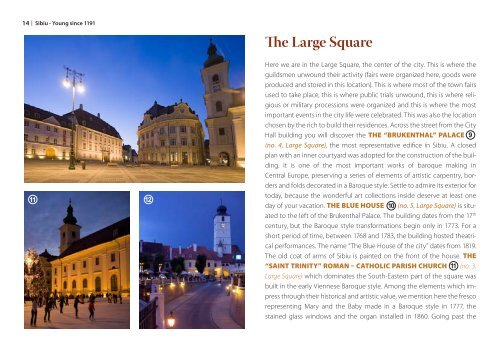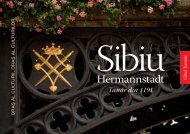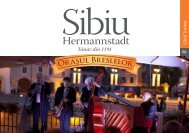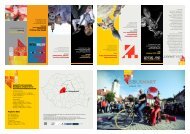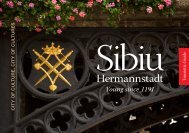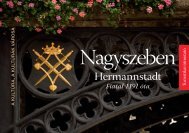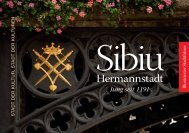Create successful ePaper yourself
Turn your PDF publications into a flip-book with our unique Google optimized e-Paper software.
14 <strong>Sibiu</strong> - <strong>Young</strong> <strong>since</strong> <strong>1191</strong><br />
11 12<br />
The Large Square<br />
Here we are in the Large Square, the center of the city. This is where the<br />
guildsmen unwound their activity (fairs were organized here, goods were<br />
produced and stored in this location). This is where most of the town fairs<br />
used to take place, this is where public trials unwound, this is where religious<br />
or military processions were organized and this is where the most<br />
important events in the city life were celebrated. This was also the location<br />
chosen by the rich to build their residences. Across the street from the City<br />
Hall building you will discover the THE “BRUKENTHAL” PALACE<br />
(no. 4, Large Square), the most representative edifice in <strong>Sibiu</strong>. A closed<br />
plan with an inner courtyard was adopted for the construction of the building.<br />
It is one of the most important works of baroque making in<br />
Central Europe, preserving a series of elements of artistic carpentry, borders<br />
and folds decorated in a Baroque style. Settle to admire its exterior for<br />
today, because the wonderful art collections inside deserve at least one<br />
day of your vacation. THE BLUE HOUSE (no. 5, Large Square) is situated<br />
to the left of the Brukenthal Palace. The building dates from the 17th 9<br />
10<br />
century, but the Baroque style transformations begin only in 1773. For a<br />
short period of time, between 1768 and 1783, the building hosted theatrical<br />
performances. The name “The Blue House of the city” dates from 1819.<br />
The old coat of arms of <strong>Sibiu</strong> is painted on the front of the house. THE<br />
“SAINT TRINITY” ROMAN – CATHOLIC PARISH CHURCH 11 (no. 3,<br />
Large Square) which dominates the South-Eastern part of the square was<br />
built in the early Viennese Baroque style. Among the elements which impress<br />
through their historical and artistic value, we mention here the fresco<br />
representing Mary and the Baby made in a Baroque style in 1777, the<br />
stained glass windows and the organ installed in 1860. Going past the


